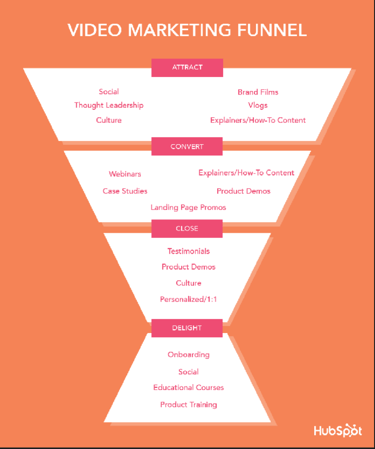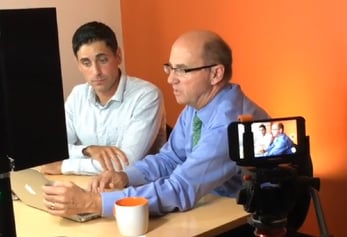Through his incredible storytelling skills, Tony Gnau enlightens us with how and why we should be fitting videos into our very own marketing funnels. Tony and his team at T60 Productions are communication experts, content creators and above all else… storytellers. They guide their clients through the corporate video production process and create videos people enjoy watching.
Here at Stream Creative, we host a quarterly Hubspot User Group event and we were excited to have Tony present and provide us with his insight.
Here are the five big takeaways that Tony shared to impact your corporate video marketing results:
1. Video Production Doesn’t Have to Be Expensive
 Video production cost can get expensive, it’s not a secret. But there are many low-cost video creation options and resources available; you just have to know where to look. One of the easiest ways is to hire a company that offers low budget video options. Not every company is out to produce commercial quality ads, so take some time to find the right fit for your needs. You can also reach out to your local high school or college and see if a media class would like to work on your company’s video as an assignment. In this scenario, the students are learning how to make a video and you get a low cost (maybe even free) video; sounds like a win-win to us!
Video production cost can get expensive, it’s not a secret. But there are many low-cost video creation options and resources available; you just have to know where to look. One of the easiest ways is to hire a company that offers low budget video options. Not every company is out to produce commercial quality ads, so take some time to find the right fit for your needs. You can also reach out to your local high school or college and see if a media class would like to work on your company’s video as an assignment. In this scenario, the students are learning how to make a video and you get a low cost (maybe even free) video; sounds like a win-win to us!
2. Use A Simple Video Methodology to See Results
Even with the best camera equipment and editing skills, there are still ways to end up with zero video views: having no plan, no promotion, and bad creative. Following a simple video process or methodology, you can ensure your video hits the right audience, with the right messages through the awareness, consideration and decision stages of your marketing funnel
It starts with making a plan, choosing the right video structure, promoting your video and finally, analyzing the results. Let’s dive a little deeper into this simple video methodology.
Make a Plan
If you want people to watch your videos, you have to create a plan. Where do you start? It’s definitely not by picking up a camera and hitting record. Start by answering these three questions:
- Who is the audience? Knowing your audience is the most important consideration. What is relevant to them? Why is your corporate video content important? What information do they value and seek?
- What is your goal? Start by deciding whether your goal is to create awareness, drive sales or to educate, etc. It will be different for every video you do, but make sure you have one so you can evaluate the success.
- How will you measure success? Before you take a look at the numbers, figure out what you want to learn. With the amount of analytics we have for digital content, we can determine the number of views, how long people are watching, and where they click after the video, etc.
Choose Your Video Structure
Most of the time, people start with what type of video they want to create. Although that’s not a wrong way to do it, Tony suggests using the data from the planning phase to help you figure out which type of video you want to make. Here are three common types of video you may consider using:
“About Us” or “Company Culture” Video
The About Us video is possibly the most important for a company to have. The About Us video is often the first impression you have with your potential customers. If someone is on your About Us page, they are there because they want to investigate what your company has to offer and what the company culture is like. What better way to show this than with real people talking directly to them, saying how you can help, what you do, what you stand for and what you’re passionate about.
“Testimonial” Video
When it comes to effectiveness, marketers often place a high value on the use of testimonial videos. As marketers, we all know that it’s extremely valuable if you can get a client or customer willing to tell others how much they like a company, a product, or service.
“Product / Service” Video
 A Product / Service video, or a how-to video, is a great way to introduce your new or existing products to potential customers. These videos are especially effective because they go beyond mere pictures and descriptions and can offer a more in-depth overview.
A Product / Service video, or a how-to video, is a great way to introduce your new or existing products to potential customers. These videos are especially effective because they go beyond mere pictures and descriptions and can offer a more in-depth overview.
Videos create tangible examples for the viewer, allowing ideas and concepts to be grasped much more easily.
There are all sorts of videos that you can create, such as interviews, live streaming videos, webinars, presentations, animated, or behind-the-scenes. But the three listed above are the core videos to start with as a business just getting into creating video content.
Promote Your Video
Remember there is more to producing a video than creating and posting it once. To take advantage of the new content asset you’ve invested in, you need to incorporate your video into your content calendar. Without having a set schedule of when and how to share the video, your video will end up being shared by everyone in the company within the first month and then nobody will share or see it ever again. Consider promotion on your social media channels, your website, blog, and even with some paid support to really get your video seen.
Analyze The Results
There is video analytics that proves the number of views doesn’t always come from the initial post that was first sent out. As an example, Tony recalls a specific time someone reached out to him explaining how they finally got around to watching a video that was included in the newsletter several times and they really enjoyed and learned so much from it. If it wasn’t for them continuously putting the video in the newsletter, that person would have never seen it. Tony explains that this happens all the time and that’s why it’s crucial to incorporate your videos or any content asset you have into your resources on a regular basis.
3. Use HubSpot’s Marketing Funnel to Know How to Position Your Corporate Video
 As a perfect marriage of the two topics we are covering, video content marketing and promotion, Tony refers to HubSpot’s Video Marketing Funnel and helps us understand where we should be placing each type of video within our customer’s buyer journey. The Marketing Funnel is a model created to help marketers visualize the process of converting leads into actual customers using stages. Use the funnel image provided by HubSpot to help conceptualize the journey a potential customer might take as they go through each stage sliding further into the conversion.
As a perfect marriage of the two topics we are covering, video content marketing and promotion, Tony refers to HubSpot’s Video Marketing Funnel and helps us understand where we should be placing each type of video within our customer’s buyer journey. The Marketing Funnel is a model created to help marketers visualize the process of converting leads into actual customers using stages. Use the funnel image provided by HubSpot to help conceptualize the journey a potential customer might take as they go through each stage sliding further into the conversion.
ATTRACT
Your inbound skills are put to the test in the attract stage. The content you create needs to be focused only on your buyer persona(s) with the answers to help their needs or pain points. Videos are a great way to make your customers aware of your product or service. Research shows that social video creates 1200% more shares than images and text combined and a landing page with a video will be 53% more likely to show up on page one of the Search Engine Results Page (SERP). To attract attention, the following types of videos are perfect for doing just that:
- Thought Leadership
- Vlogs
- Company Culture
- How-To
A company culture video is something you might want to consider providing at the top of your funnel because people want to believe in the company that they’re doing business with. This can show how you treat your employees, what kind of social citizen your company is, or how you’re giving back to the community.
CONVERT
You will want to focus on converting your prospective customer into a lead when they are in the middle of the funnel. This is when they are evaluating whether your product or service is a perfect fit for them. Using any of these types of videos, you can provide the information your customer needs to take the next step:
- Webinars
- Case Studies
- Product/Service
If you’re looking for a low-cost video… webinars are a great way to convert your customers into leads with a shallow budget. You don’t have to hire a big production company to do this; all you have to do is screen-capture some presentation notes and do a voiceover. With a webinar, you are able to share your expertise or show your customers something that you do that’s going to help them.
CLOSE
The customer is at the bottom of the funnel when they are in the close stage. This is also known as the purchasing stage because your customer is about to buy the product or service. The reason you need to continue creating video content in this final stage is that it doesn’t necessarily mean they are going to buy from you. Your potential customer is looking for just the right offer or Call to Action (CTA). As you’re getting ready to close the deal, here are some videos to choose from to convert potential customers to clients:
- Testimonials
- Company Culture Videos
- Proposal Videos
Giving someone confirmation from an outside source stating that you do what you say you do (and you do a great job at it) might be the thing your customer needs before they make their decision to buy from you.
Why is company culture in two different layers of the funnel? First, we will refer you to what you just learned about the reuse of content. If someone is about to buy a product or service from two different companies, your culture could be what puts you ahead of your competitor. That person might not have caught your company culture video as they were in the attract stage, but luckily, you can reuse the video and work it into their buyer’s journey in another way.
DELIGHT
But wait, there’s more! As an added value (just like what you can provide to your customers), HubSpot has included a section below the funnel and they call this “Delight”. The four main pillars of delight include solving problems, being helpful, achieve goals, and being enthusiastic. Here are a few examples of what delight could include:
- Educational Courses
- Product Training
- Fun Videos
Once your customer is through the funnel, it doesn’t mean you should stop supplying content for them to use. We all know that it’s easier and cheaper to sustain a current customer than it is to find and attract new prospects; so why wouldn’t you make time for delighting your current customers?
An educational course or product training video might be just what you need to create added value for your customer after they’ve made their purchase with you. Another unexpected way to delight your customer is providing a “fun” video. Something that makes your customer feel like they know you on a personal level -- like they’re a part of your family or company. Show off your annual summer company barbeque or your office contests and keep your customers in the loop.
4. Facts and Figures Don’t work in Videos
Videos are not for throwing out facts and figures. When you’re producing videos, you’re not going after people’s minds, you’re going after their hearts. Facts and figures are great for your website and all sorts of marketing campaigns, but avoid this in your marketing videos.
Instead, focus your creative angles on eliciting emotion to make the viewer feel something. So how exactly do you drop the facts and figures and still get your points across? You can do this through storytelling. Research shows that stories are so powerful, people often lose track of what is a story and what is reality. As marketers, we want our customers to have emotion and feel something.
An expert in communications and friend of Tony’s, Rob Biesenbach, once said in one of his presentations on storytelling and public speaking:
“Facts are called ‘cold’ and ‘hard’ for a reason because they don’t have the ability to warm hearts, which is the key to changing minds.”
If that wasn’t enough to convince you of the importance, Seth Godin, a marketing author, blogger, and TED Talk lecturer, says: “People are moved by stories and logic is a battering ram”.
5. Find Stories for Your Video
If you are wondering how to get started with storytelling, there are few simple assets you likely already have that can help.
FAQs
You probably already have a frequently asked questions page on your website. You can use your FAQs to come up with stories that address the answers to those questions. You can even speak to why these questions might be so frequently asked. Are there industry-wide myths or misunderstandings you can touch on?
Your Current Employees
 Every one of your employees or team members has a story. It could be about what they do at their job, how they got their job, their history with the company, or even their hobbies! The whole point of telling the stories of your employees is to make your company human, accessible, and approachable. If you can make your customers feel like they are getting to know your employees, they will think of your company as their neighbor that they trust and will want to support.
Every one of your employees or team members has a story. It could be about what they do at their job, how they got their job, their history with the company, or even their hobbies! The whole point of telling the stories of your employees is to make your company human, accessible, and approachable. If you can make your customers feel like they are getting to know your employees, they will think of your company as their neighbor that they trust and will want to support.
Current Events
Follow current events and relate them back to your business. Doing something as simple as a vlog and having someone talking about a current event and giving the company’s opinion or outlook is a great way to share a story and even helps you stay relevant.
Find Your Specialty
What makes you unique as a company? Find what makes you an industry differentiator and talk about how you got there, or why you decided to get into this business.
Use the Power of Search
Finally, type in your industry into the YouTube search bar and see what others have done. If your company is an accounting firm, you may think your creative capability is limited, however, if you did a quick YouTube search, you’ll find over 60,000 results! Some examples of accounting related videos include: ‘a day in the life of an accountant’, ‘how to start bookkeeping for small businesses’, ‘accounting office flash mob dance’, or ‘the difference between accounting and bookkeeping’. To make a long story short, in the words of Tony Gnau, “If an accounting firm has stories to tell, your company has stories to tell as well”.
Facts and figures might work great in a blog or website, but when it comes to video, you have to be prepared to tell a story. You also need to be prepared to have a well thought out plan that includes answering who the audience is, your goal, and how you’ll measure success. After choosing your video structure and the stage of the buying process you want to target, don’t forget to have fun with it, especially if you’re creating a video to delight your customers!
If you enjoyed this content, you guessed it, it’s available in video!




